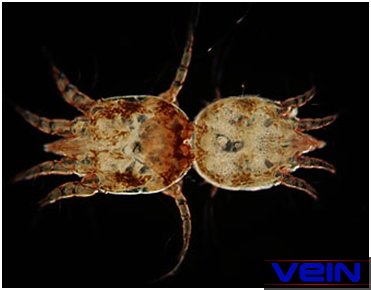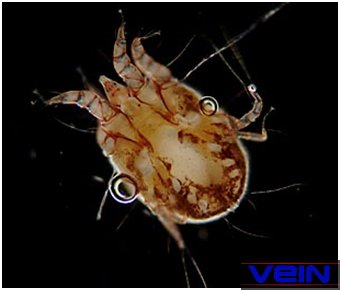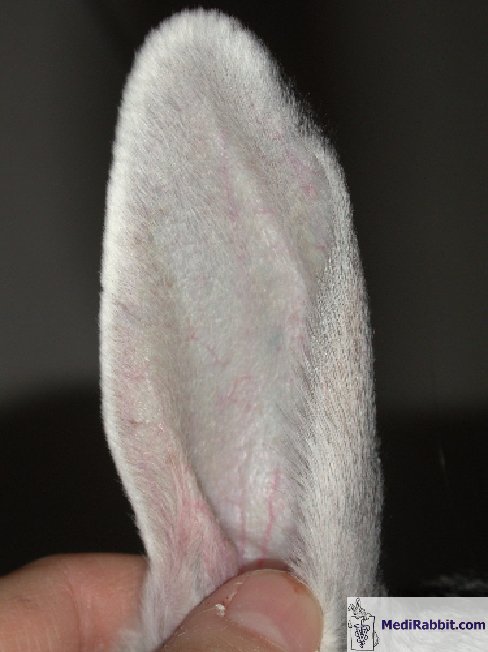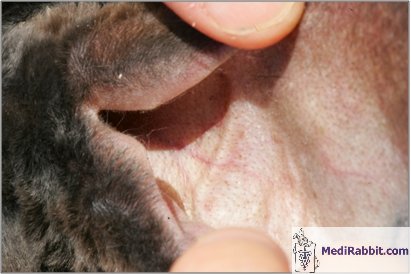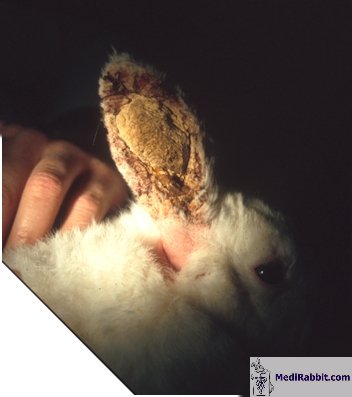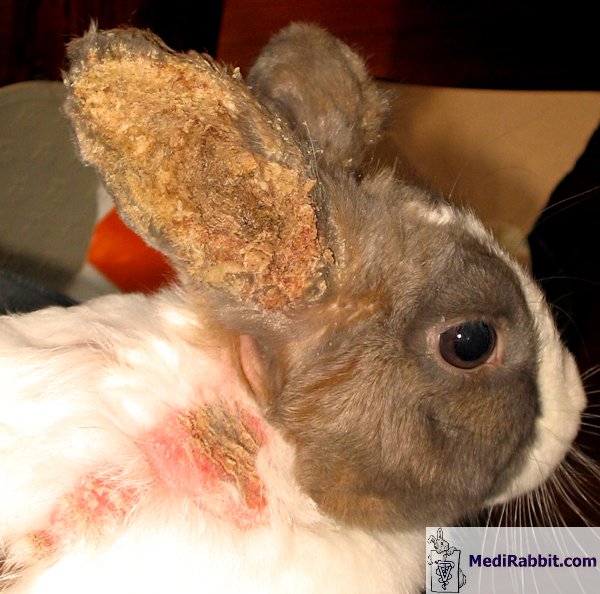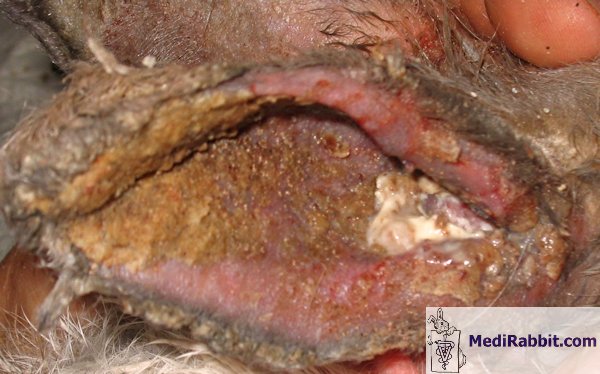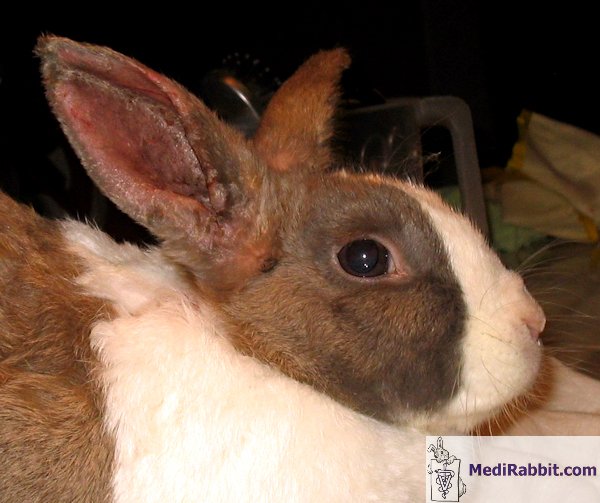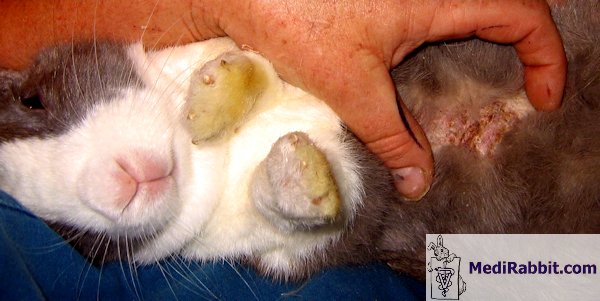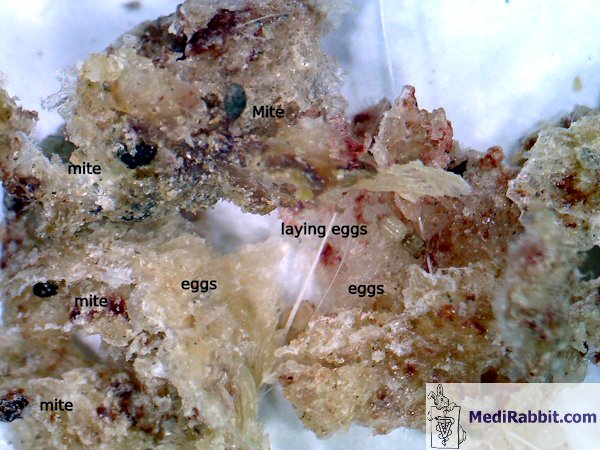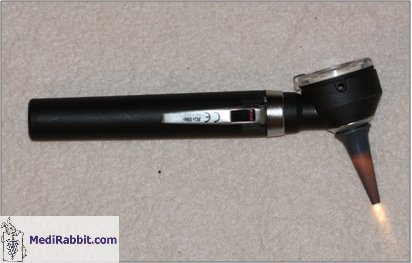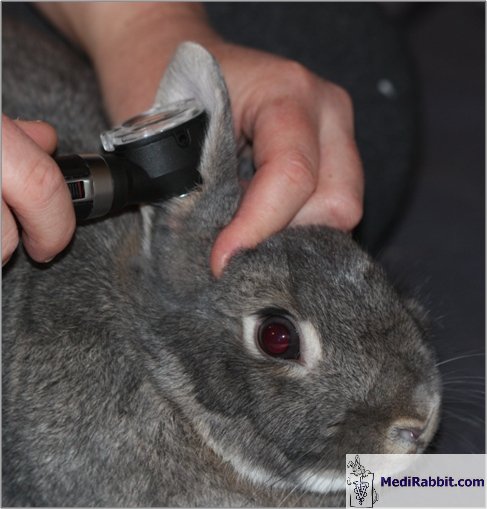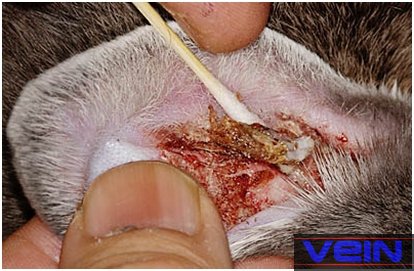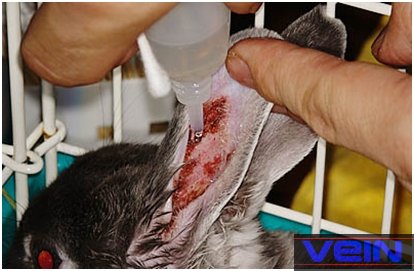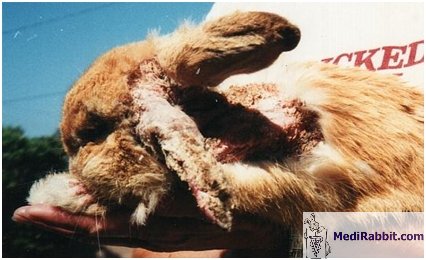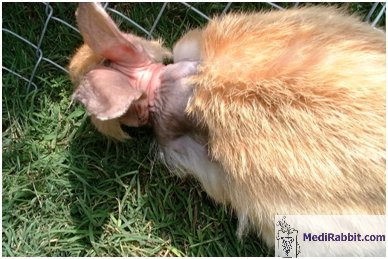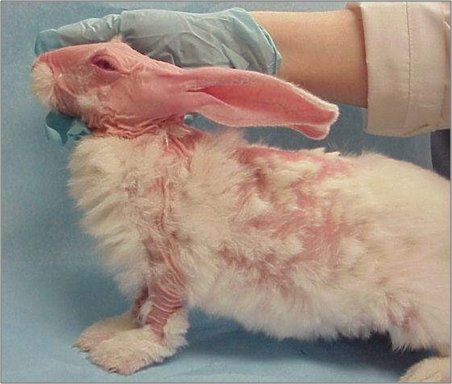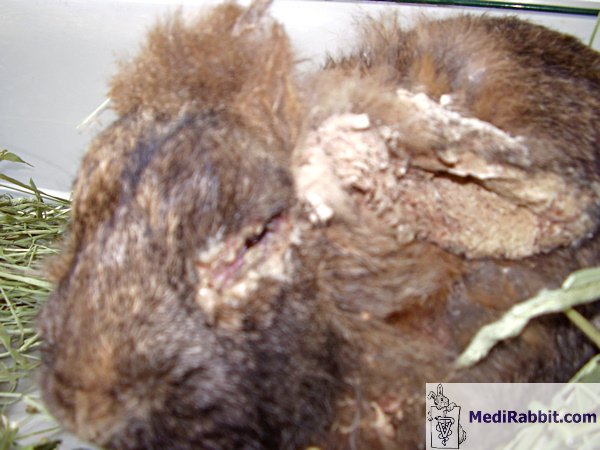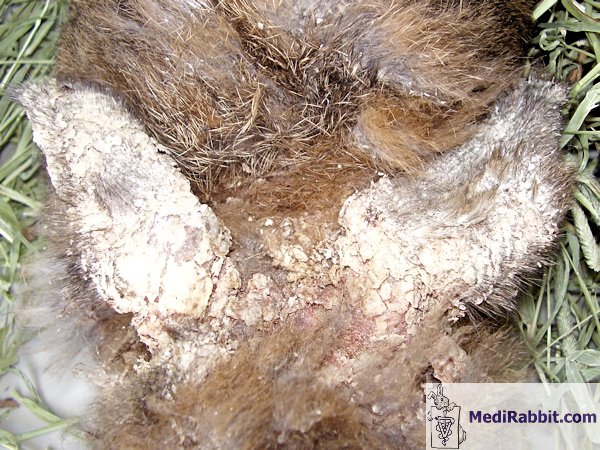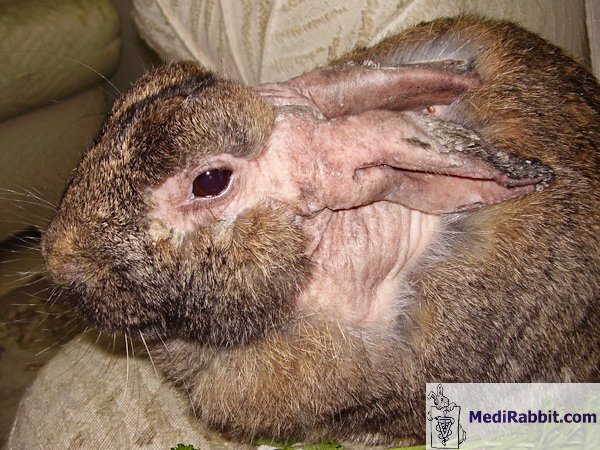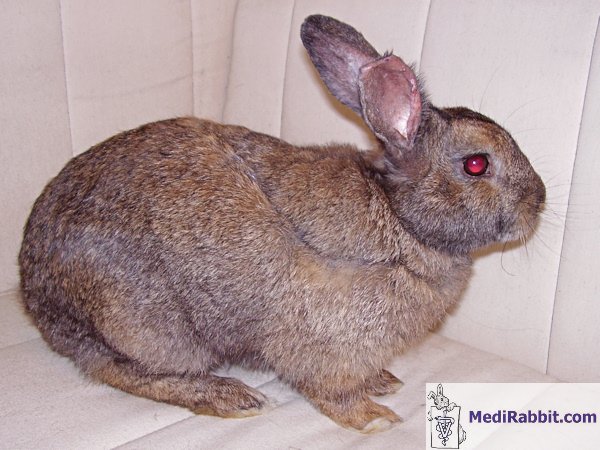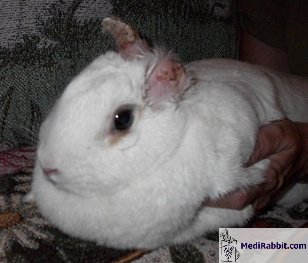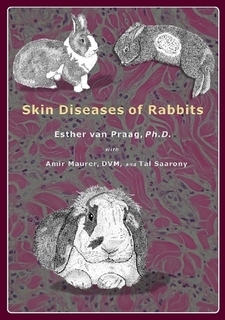Øremidd: Psoroptes
cuniculi
Esther van Praag, Ph.D. - Oversettelse av Camilla Bergstrøm
|
MediRabbit.com is funded solely by the
generosity of donors. Every donation, no matter what the size, is appreciated and will aid
in the continuing research of medical care and health of rabbits. Thank
you |
Warning:
this file contains pictures that may be distressing for some persons
Øremidden er den universale parasitten Psoroptes
cuniculi. Den har fire livsstadier: egg, larve, nymfestadiet og voksen midd.
Livssyklusen varer omtrent 21 dager, avhengig av miljø, og eggene klekkes
etter fire dager.
Psoroptes cuniculi blir hovedsakelig funnet i
kaninens pinna (det ytre øre), og det er ikke uvanlig at bare det ene øret
rammes. Hvis ikke parasitten elimineres ordentlig hos gamle og syke dyr, kan
den spre seg til hode, nakke, ben, buk og rundt anus. Parasittens slim og
avføring forårsaker en betennelsesreaksjon som får kaninen til å begynne å
klø seg i øre. Blodet som kommer ut fra de oppskrapte sårene fungerer som
næring for parasittene.
Symptomer
Irritasjon i øret og hyppig risting av hode og ører.
Kaninen klør seg så kraftig i øret at det grenser til selvmutilasjon. I
begynnelsen kommer små tette hudflak til syne dypt inne i ørekanalen. Ørene
er omringet av hårløse områder. De gulgrå flakene kan være ganske tykke. De inneholder utallige parasitter, middavføring, hudceller og
blod.
Hvis behandling
ikke startes innen dette stadiet vil flakene utvikle seg til skorper, som i
ekstreme tilfeller, kan nå en tykkelse på 2 cm. Kaninen kan ikke lenger holde
øret oppe, og det faller ned til siden. Flakene/skorpene bør absolutt IKKE
fjernes, da dette vil etterlate huden blodig og erodert. Ofte kan smerte i
ytre øre og området rundt observers. The crust will fall off within 10
days after the first administration of oral or injected ivermectin. Earlier
removal is also very painful, and may lead to screaming.
Video
by D. Hanson Sårene som forårsakes av midd kan infiseres, selv om en
slik infeksjon er unngåelig. Hvis tilstanden ikke blir behandlet vil
bakteriene spre seg og forårsake hyperkeratotisk (unormal fortykkelse av
huden) otitis externa (infeksjon i ytterøret). Infeksjonen kan spre seg
innover og gjøre at trommehinnen sprekker, og infeksjon oppstår i indre øre.
Diagnosis
Kaniner kan
angripes av øremidd. En visuell undersøkelse er ikke alltid tilstrekkelig for
å bekrefte tilstedeværelse av midd. Man foretar som regel en avskrapning av
det øvre hudlaget. Prøver fra avskraping spres på et objektglass, oppløses i
KOH, og eksamineres under et mikroskop. Sjansen er stor for at man oppdager
midd, larve eller egg. Man kan også ta prøver av hår. Håret oppløses i KOH og
eksamineres under mikroskop for å oppdage eventuelle egg.
Hvis midd ikke
blir funnet i den første prøven, bør man ta prøver fra andre steder på
kroppen. Hvis man mistenker skabb, men ikke finner noen etter en dyp
avskraping, er det best å foreta en biopsi på det mistenkte området.
Behandling
The scales/crust should never be
removed !!!
Removing them is
horribly painful to the rabbit, leading to screaming (see video).
Øremidd elimineres
med avermectiner:
• Ivermectin: 0.4 mg/kg, PO (oral) eller SC, 3 ganger med intervaller
på 14 dager (Livssyklusen til Psoroptes cuniculi er 21 dager) 0.2 mg/kg har
vist seg å være lite effektivt.
• Selamectin: Revolution® (US) or Stronghold® (Europe) -
Pfizer, 6-18 mg/kg. eller
Stronghold® (Europa) – Pfizer, 6-18 mg/kg. En enkel topisk dose burde være
tilstrekkelig, hvis ikke, repeter etter 30 dager. If the affected rabbit presents
severe anemia, a transfusion of blood can be attempted from a healthy donor
rabbit.
• Moxidectin (Quest® or Equest® -
Fort Dodge). Dette medikamentet har ennå ikke vist seg å ha noen bivirkninger ved
PO administrering, men kan ha bivirkninger ved SC administrering.
Disse 3 avermectin-preparatene tar ikke knekken på
eggene, men forblir i vevet lenge nok til å drepe larvene som kommer ut av
eggene. Ivermectin diluted
in mineral oil, applied directly on the ear, is less effective than injected
or oral ivermectin.
The use of over the counter products against mite or ear
mites should be avoided. Most contain pyrethrin. While one of the least toxic
insecticides for animals and rabbits, pyrethrins/pyrethroids are neurotoxins which lead to continuous
"firing" of nerves. Observed problems in rabbits include limb
paralysis, seizure, coma, tremor, sometimes death.
Many of those products contain additives that prolong the
effect of the pyrethrins, and inhibit the breakdown
of these products in the body. They can lead to toxic reactions in rabbits. Piperonyl butoxide is one of
them. If no immediate death, there should be **slow** recovery with time,
around 48 h.
Ekstrakt fra Artemisia verlotorum (kinesisk malurt) har
vist seg å være effektivt mot Psoroptes cuniculi.
Hvis kaninen har smerter bør et smertestillende middel
som carprofen (Rimadyl), ketoprofen eller meloxicam administreres.
Eventuelle sekundære bakterieinfeksjoner bør behandles
med antibiotiske øredråper så lenge infeksjonen er liten og trommehinnen er
intakt (Hvis trommehinnen har sprukket kan bruk av øredråper være fatalt).
Infeksjon i ytre øre forårsaker ikke ”skeivt hode”, i motsetning til infeksjon
i indre øre.
Ved alvorligere infeksjon i mellomøret anbefales
øredråper og antibiotika. If the amount of pus and debris in the outer ear is high,
the use of enzymatic solution such as Zymox Otic and flushing of the ear is recommended. This will
help bring the medication deep in the ear canal. Hvis puss er synelig anbefales
kulturprøve og sensitivitetsprøve for å avgjøre hvilket antibiotikum som er
mest effektiv.
Ved infeksjon i indre øre må riktig type antibiotika
administreres oralt.
Ear mites can fall off and contaminate the environment.
While treating for mites, careful cleaning of the cage and environment is
recommended. Treatment of the environment is important (boric acid such as Fleabusters®; Vet-Kem Acclaim
Plus® - Sanofi; Staykil® - Novartis; Indorex® - Virbac; acaricide spray). When treating a carpet, vacuum first in
order to further penetration of the spray or powder. Shampooing and steam
cleaning are not ideal; their residual humidity can increase the mite
problem. During treatment of the environment, rabbits should be kept in
another part of the home to avoid the danger of contact with the products.
Takk til...
Thanks are due to Zahi Aizenberg, DVM (The Koret School
of Veterinary Medicine, the Hebrew University of Jerusalem, Israel), to Dr.
Orlando Diaz, (www.lakehowellanimalclinic.com), to Akira Yamanouchi,
(Veterinary Exotic Information Network, https://vein.ne.jp/, Japan), to Crystal Gaydos
and Caroline Charland (www.bunnybunch.org, USA), to
Linda Baley (USA), and to Christine Macey (USA) for the permission to use
their pictures. To Debbie Hanson for sharing the news related to Parker, to
Hugh Hanson, for sharing the video showing life ear mites. To the rabbits
Kaspi, Flora Adar, Parker and those whose name is unknown, but were severely
affected by ear mite.
For detailed information on ear
mite infestation in rabbits, see: “Skin Diseases of
Rabbits”, by E. van Praag, A. Maurer and T. Saarony, 408 pages, 2010. Videre Informasjon
Beck W. Farm animals as disease
vectors of parasitic epizoonoses and zoophilic
dermatophytes and their importance in dermatology. Hautarzt.
1999; 50(9):621-8.
Bowman DD, Fogelson ML, Carbone
LG. Effect of ivermectin on the control of ear mites (Psoroptes cuniculi)
in naturally infested rabbits. Am J Vet Res. 1992; 53(1):105-9.
Cutler SL. Ectopic Psoroptes
cuniculi infestation in a pet rabbit. J Small Anim Pract. 1998;
39(2):86-7.
Nfi AN. Ivomec, a treatment against rabbit mange. Rev Elev Med Vet Pays Trop. 1992; 45(1):39-41.
Pap L, Sarkozy P, Farkas R, Bleicher E, Szego A. Efficacy
of some pyrethroids against a strain of the rabbit
ear mite (Psoroptes cuniculi): an unusual cross-resistance pattern. Parasitol Res. 1997; 83(2):203-5.
Perrucci S, Cioni PL, Flamini G, Morelli I,
Macchioni G. Acaricidal
agents of natural origin against Psoroptes cuniculi. Parassitologia.
1994; 36(3):269-71.
Perrucci S, Cioni PL, Cascella A, Macchioni F. Therapeutic efficacy of linalool for the
topical treatment of parasitic otitis caused by Psoroptes cuniculi in
the rabbit and in the goat. Med Vet Entomol.
1997; 11(3):300-2.
Perrucci S, Flamini G, Cioni PL, Morelli I,
Macchioni F, Macchioni G.
In vitro and in vivo efficacy of extracts of Artemisia verlotorum against Psoroptes cuniculi.
Vet Rec. 2001; 148(26):814-5. No abstract available.
Sanders A, Froggatt P, Wall R,
Smith KE. Life-cycle stage morphology of Psoroptes
mange mites. Med Vet Entomol. 2000; 14(2):131-41.
Smith KE, Wall R, Berriatua E,
French NP. The effects of temperature and humidity on the
off-host survival of Psoroptes ovis and Psoroptes
cuniculi. Vet Parasitol. 1999;
83(3-4):265-75.
Wagner R, Wendlberger U. Field
efficacy of moxidectin in dogs and rabbits
naturally infested with Sarcoptes spp., Demodex spp. and Psoroptes spp. mites. Vet Parasitol. 2000; 93(2):149-58.
|
e-mail: info@medirabbit.com



